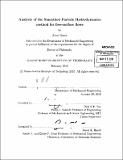| dc.contributor.advisor | Dick K.P. Yue. | en_US |
| dc.contributor.author | Kiara, Areti | en_US |
| dc.contributor.other | Massachusetts Institute of Technology. Dept. of Mechanical Engineering. | en_US |
| dc.date.accessioned | 2010-08-31T16:22:41Z | |
| dc.date.available | 2010-08-31T16:22:41Z | |
| dc.date.copyright | 2010 | en_US |
| dc.date.issued | 2010 | en_US |
| dc.identifier.uri | http://hdl.handle.net/1721.1/57890 | |
| dc.description | Thesis (Ph. D.)--Massachusetts Institute of Technology, Dept. of Mechanical Engineering, 2010. | en_US |
| dc.description | Cataloged from PDF version of thesis. | en_US |
| dc.description | Includes bibliographical references (p. 306-309). | en_US |
| dc.description.abstract | Smoothed Particle Hydrodynamics (SPH) is a simple and attractive meshless Lagrangian particle method with applications in many fields such as astrophysics, hydrodynamics, magnetohydrodynamics, gas explosions, and granular flows that has demonstrated ability to simulate highly non-linear free-surface flows including wave overturning, jets, and the formation of spray and droplets. Despite the increasing popularity and promise of the method, SPH has a number of key issues that must be overcome before the method can realize its full potential in scientific and engineering applications: it is of low order, requires a high degree of tuning, and is inherently unstable. Additionally, there exists little analytic basis or fundamental understanding of the method to guide the many ad-hoc tuning and empirical fixes. The objective of this thesis is to perform an analytical and numerical investigation of the SPH method for free-surface flows. To this end, we perform a quantitative, unified analysis of the numerical method and the physics it captures, and we assess the method's consistency, stability, and convergence. It is shown that SPH introduces spurious solutions dominant in the dynamics of the solution making quantities such as velocity and pressure essentially unusable without filtering. It is also shown that the method is consistent inside the domain but imposes spurious, leading order, dynamic free-surface boundary conditions which alter the flow and further permit the introduction of spurious solutions. We further extend the analysis to address the effects of different empirical SPH treatments introduced in the literature, classifying these respectively as accuracy, consistency, or stability treatments, and characterizing their effectiveness. Based on the findings of the analysis, we eliminate the tuneable and empirical nature of the method by providing rational guidelines for the usage and effects of the relevant SPH treatments. Finally, we propose a modified SPH method that maintains the key features of SPH and significantly reduces spurious errors present in current SPH implementations. This thesis is among the first to provide a unified systematic analysis of the SPH method, shedding insight into the many proposed variations and fixes, and informs and guides new rational improvements to the method. This work lays the foundation for the development of SPH as a valuable engineering tool in the study of violent free-surface flows. | en_US |
| dc.description.statementofresponsibility | by Areti Kiara. | en_US |
| dc.format.extent | 309 p. | en_US |
| dc.language.iso | eng | en_US |
| dc.publisher | Massachusetts Institute of Technology | en_US |
| dc.rights | M.I.T. theses are protected by
copyright. They may be viewed from this source for any purpose, but
reproduction or distribution in any format is prohibited without written
permission. See provided URL for inquiries about permission. | en_US |
| dc.rights.uri | http://dspace.mit.edu/handle/1721.1/7582 | en_US |
| dc.subject | Mechanical Engineering. | en_US |
| dc.title | Analysis of the smoothed particle hydrodynamics method for free-surface flows | en_US |
| dc.type | Thesis | en_US |
| dc.description.degree | Ph.D. | en_US |
| dc.contributor.department | Massachusetts Institute of Technology. Department of Mechanical Engineering | |
| dc.identifier.oclc | 648975362 | en_US |
